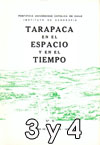The map of the Quebrada de Tarapacá, by Don Antonio O''Brien. Its geographical and socio-anthropological value.
Keywords:
Geografía humana, geografía histórica, Quebrada de Tarapacá, Antonio O'BrienAbstract
Quebrada de Tarapacá from the altiplano sector to its mouth in the Tamarugal pampas. The approach is simultaneously geographical, historical and anthropological, trying to extract all the information concerning human settlements, distribution and importance of the population, communication network, and even archaeological ruins in the area. The reasons that the author had for the preparation of the plan from the administrative-tributary and economic-hydrological point of view are studied in detail. Useful inferences emerge from this analysis about the alternation of climatic cycles, wet and dry, during part of the 18th century. Likewise, a picture of the geographical characteristics of the indigenous communities is obtained. It concludes with observations on the progressive climatic desiccation in the northern Chilean desert and the subsequent depopulation of the area.






